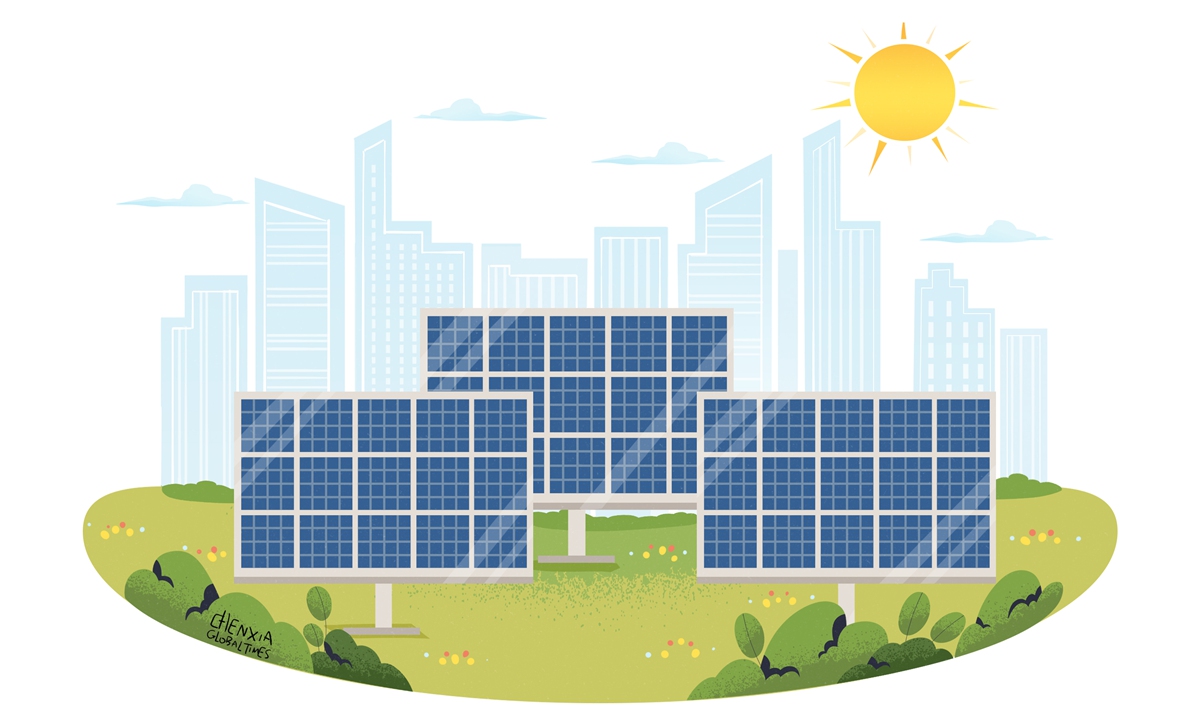
Illustration: Chen Xia/GT
India's Adani Group is planning a 150 percent increase in its output of solar panels by 2026 to bolster the country's carbon net zero target and reduce dependence on China, Bloomberg reported on Wednesday. However, it may be not smooth sailing ahead.
The Indian government's orders on attempts to increase local sourcing of solar modules to support the domestic renewables manufacturing ecosystem has been widely reported in the media as "import restrictions," according to Indian newspaper The Hindu.
This follows an order by the Ministry of New and Renewable Energy on March 29 to re-implement its 2021 notification of an "Approved List of Models and Manufacturers of Solar Photovoltaic [PV] Modules," also called the ALMM list.
With import barriers, tangible or intangible, India has created many obstacles to the import of solar modules. The purpose is to boost local manufacturing, but the lack of technology and an incomplete industrial chain make it a challenging task.
In March 2023, India suspended the roll-out of the ALMM of Solar Photovoltaic Modules Order, 2019 for fiscal year 2024 to ease the shortage of domestic solar panels, according to The Hindu. Imports from China were cheaper despite a 40 percent import duty, the report said, citing the CEO of a solar panel company.
China does not rely on so-called government incentives to form a competitive advantage. Its cost advantage can be attributed to multiple factors including technological innovation, a complete industry chain and skilled workers.
India has some key advantages for manufacturing, such as a demographic dividend and expanding consumption. In the meantime, a series of challenges, including weak industrial infrastructure, constrain the development of India's manufacturing sector. For instance, energy and electricity costs in India are high and pose a perennial challenge for the economy.
Besides, many local manufacturers depend on imports for various components. With a strong focus on becoming a global manufacturing hub, India aims to establish a robust presence across the solar energy value chain, but this goal cannot be achieved overnight.
As the world eyes decarbonization on a huge scale, effective climate and economic policies are key. India's carbon footprint is growing as it strives to develop. The country has promised to cut its emissions to net zero by 2070. This means India has to accelerate the development of a green economy.
India has 424 gigawatts of power generation capacity, including about 180 gW from non-fossil fuels, the Economic Times reported in 2023. The country has a target of 500 gW of renewable energy capacity by 2030. Analysts believe India will need to add 30 gW of solar energy capacity annually to meet the 280 gW solar capacity installation target by 2030, according to media reports.
The Indian government has launched production-linked incentive programs, but that may be not enough to boost local manufacturing. The country needs to strengthen international cooperation to help promote the sound development of its solar energy industry.
For China and India - two emerging markets with big potential in developing the green economy - effective economic and trade cooperation is in the interests of both countries and their companies. If companies from the two countries can take advantage of their economic complementarity, pushing up exports and imports of intermediate products, both countries' green transformations will gain greater momentum.
India should further open its market to global enterprises. At the very least, the country needs to support free trade and reduce trade barriers for solar module producers.
The author is a reporter with the Global Times. bizopinion@globaltimes.com.cn




